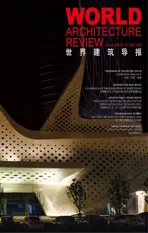卢布尔雅那城市博物馆
2016-11-29TomazGregoric
卢布尔雅那城市博物馆
斯洛文尼亚 Ljubljana
建成时间:2000-2004年
摄影:Tomaz Gregoric
竞标
这项工程包括对位于卢布尔雅那这座受国家保护的历史古城中心奥尔斯佩格宫的改造和扩建。竞标设计提出建造螺旋式的走廊,连接宫殿两翼,供游客穿过展览区,因为这些空间原来设计较为复杂而且互不相连。
宫殿历史
该建筑历史悠久,创建时期可追溯到史前时期至罗马和中世纪,每个时代都有扩建。直到十七世纪,该建筑的层面布局一直是(十六世纪前)的三层结构。1654年到1658年之间,采用了立面设计,庭院中增加的拱形走廊衬托出当时流行的巴洛克风格。1709年至1720年间,增加了北侧的翼楼,还新建了楼梯和两个大厅。最后于1820年,增加了天花板,关闭了拱门,立面上还增设了小窗户。1935年,这座宫殿正式成为布尔雅那城市博物馆,战后该建筑内还有其他的机构,其中包括一家图书馆和档案馆。该建筑的结构日益老化,已经不堪承担重负,到2000年,这座宫殿已日渐破败,翻新改造已经迫在眉睫。
翻新改造
翻新改造前,因为怀疑庭院和内部中庭下面有很多考古遗迹,首先进行了大规模的考古研究。开始发掘前,人们不知道哪里会有这样的遗迹,也不知道其重要性。博物馆的扩建设计与现场发掘同时进行,采用一种开放式的结构体系,以便根据考古学家们的发现随时调整。
考古学家发现了史前墓地、罗马建筑的残迹和一条曾经连接艾摩那古城与罗马其他城市的主要道路。这条始建于公元一世纪的道路宽近8米,一直保持到中世纪,对这座城市后来的格局有着显著的影响。
扩建与游客体验
第一道螺旋式走廊——游客从地下3米深处起步,这是史前时期的地表高度。游客沿着走廊随着城市的地表高度逐步上升,到达这座城市在罗马时代的地表高度,这象征最初的罗马道路。这条走廊再带游客来到具有中世纪巴洛克风格的卢布尔雅那,驻足博物馆酒吧,再返回到一楼大厅。这里的考古遗迹保持原样——就连石头也留在原地。庭院地面有两条和古罗马道路平行的走廊,在下方阶梯式分布的考古遗迹上方形成一个屋顶。
第二道螺旋式走廊——位于地下3米到地表之间的古迹上方,由庭院向上形成一个地平高度阳台,游客在这里可以从各个角度俯视庭院。第三道螺旋式走廊——一直上升到宫殿内4米的高度,形成一个平台可供游客俯视大厅。沿旧楼梯而上,这道走廊(在7.5米的高度)成了悬空平台,内有各种服务设施:空调设备、漫射灯光设备、声控设备以及防火系统。这条悬空走廊继续穿过各个房间,带游客经过各个展区,第四层(12.5米的高度)的走廊也是一样。
翻新方案打算拆除过去为了满足建筑物不断变化需要的历年改建建筑,而让奥尔斯佩格宫恢复原状,让游客们看到它的最初设计风格。这座宫殿的翻新尽量追求精简,采用无框门窗和中性材料。根据保护性翻新设计方案,展览空间保留原来的规模,新增设的陈设也与原墙体自然融合。门窗玻璃的颜色采用考古学家建议的颜色,用以区分不同的历史时代。
Competition
This project involves the renovation and extension of the Auersperg Palace, located in the heart of the protected historical city centre of Ljubljana. The competition entry suggested a spiral itinerary for the visitor to walk through exhibition spaces with added element between the wings of the palace, as the spaces were previously labyrinthine and disconnected.
Palace History
The palace and its site have a very rich history from the prehistoric period to Roman and medieval times, with each era adding something to the building. Until the 17th century, three older (pre-16th century) structures shaped the floor plan of the palace. Between 1654 and 1658, the façade was adapted and arched corridors lined the courtyard to suit the new baroque fashion. After 1709,with a new north wing built between 1709 and the 1720, a new staircase and two large halls were constructed. Finally, in 1820, new ceilings, the arches were closed and small windows were added on the facade. The palace officially became the City Museum of Ljubljana in 1935, and shared the building with other institutions like a library and archive in the next decades after the war. The weight of these programs had been too much for the deteriorating structure, and by 2000, renovating the palace became a priority due to the decay of the building.
Renovation
In preparation for the renovation, a large-scale archaeological research was conducted, with suspicion that there were rich archaeological remains under the courtyard and the internal atrium. Before beginning excavations, it was unknown where these findings would be or how important they would be. The design of the museum extension occurred parallel to the excavations on site, with an openplan structural system that was adaptable to archaeologists' suggestions.
Archaeologists uncovered prehistoric graves, remnants of Roman buildings, and a main road that once connected the ancient city of Emona with other Roman cities. The road, built in the beginning of the 1st C. AD was almost 8 m wide, and its maintenance in the early middle ages had a significant impact on the layout of the city in the future.
Extension and Visitor Experience
The first spiral … The visitors' walk begins at -3 m, where the ground level was situated in prehistory. Since the city's ground level rose over the years, the walkway ascends up to the era of Rome,represented by original Roman road. The path then takes the visitor to medieval and baroque Ljubljana, where the museum bar is located, before returning to the ground-floor lobby. The archeology is preserved in situ - no stone has been relocated. The courtyard floor bifurcates and rises parallel to this path and the location of the Roman road, forming a roof above the stepped archeology. The second spiral … functions as a roof over the archeology from level -3 m to level 0, rising from the courtyard and becoming a level balcony, affording different views of the courtyard and the palace.
The third spiral … continues inside the palace on level +4 m as a balcony overlooking the main hall. Ascending up the old staircase, the spiral becomes a suspended ceiling (at 7.5 m) containing the whole service infrastructure: climate control, diffuse lighting, the sound and fire protection system. The suspended spiral continues through the rooms taking the visitor through the exhibition, a situation that gets repeated on the next floor (at 12.5 m).
Elements that had been altered over time to suit the building's changing needs were to be stripped back to their original states so that visitors could enjoy the building as it was originally designed. The existing palace was renovated using necessary, minimal elements like frameless glass surfaces,invisible doors and neutral materials. The exhibition spaces are preserved at their original size, as per the conservation program. Furniture in the palace is integrated within the existing walls. The colors of the glazed surfaces arise from the ones used by archaeologists to define different historical eras.
City Museum Ljubljana

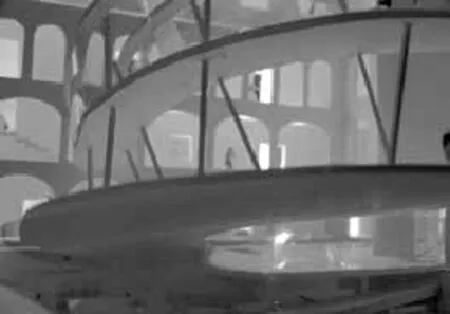

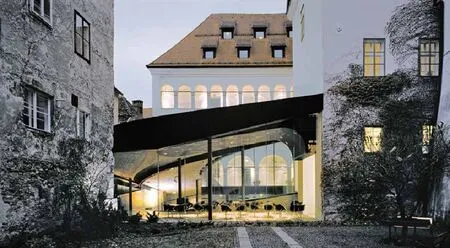


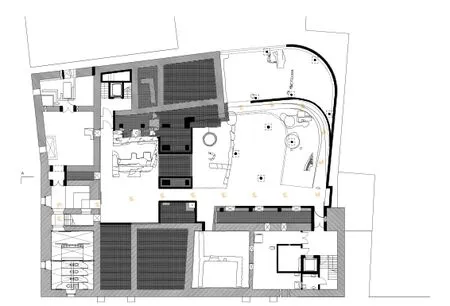
负一层平面图

一层平面图
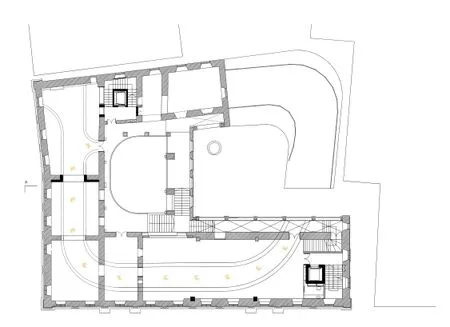
二层平面图

三层平面图

